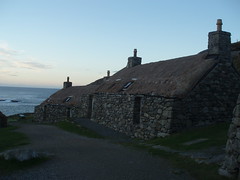 Spent an enjoyable afternoon out and about, after jumping on the 2.30 bus to Garenin on the west coast of Lewis. Most passengers had alighted by the time we approached Carloway, and there we sat for about 10 minutes. Just after half past three, a bevvy of primary school kids came on board, to be deposited outside their respective houses around Carloway. Garenin is nearly 2 miles west of that village. It looked wintery and deserted. Which it was. All the houses were locked up, and there was nobody in the office. Fortunately, ran into a couple who had been out walking and offered a lift back to Stornoway. Which saved a wait of half an hour in a cold wind, and another wait of 20 minutes at Carloway for the connecting bus service. The lift givers took the alternative route, along the Pentland Road - one of my favourite island roads. Returned to town by about 4.45pm, an hour ahead of schedule. Which meant I had an entire hour to play with this evening.
Spent an enjoyable afternoon out and about, after jumping on the 2.30 bus to Garenin on the west coast of Lewis. Most passengers had alighted by the time we approached Carloway, and there we sat for about 10 minutes. Just after half past three, a bevvy of primary school kids came on board, to be deposited outside their respective houses around Carloway. Garenin is nearly 2 miles west of that village. It looked wintery and deserted. Which it was. All the houses were locked up, and there was nobody in the office. Fortunately, ran into a couple who had been out walking and offered a lift back to Stornoway. Which saved a wait of half an hour in a cold wind, and another wait of 20 minutes at Carloway for the connecting bus service. The lift givers took the alternative route, along the Pentland Road - one of my favourite island roads. Returned to town by about 4.45pm, an hour ahead of schedule. Which meant I had an entire hour to play with this evening.It was cold today, with a thin wind, but with a beautiful winter's light. Although the daylight hours now come at a premium, I have to admit there is a serene, quiet beauty in this time of year. The tourists have virtually disappeared, and the buses are now the domain of the local residents. By mid afternoon, they head home from their shopping sprees in Stornoway, dropped at their door by the drivers. You can join or leave a bus at any point in this island, and my 27 mile journey to Garenin only cost me £4.40 return.


